READING Normal People
DORTHE HJORT JENSEN
Columbus TEMATISK VÆRKLÆSNING
Forord xx
Organisering af værklæsningen xx
Tematisk læsning af Normal People xx
1
INTRO
Sally Rooney xx
Ireland in the 2010s xx
2
READING
Reviews xx
Anne Enright: It is time for a sharp inhale, people.
Sally Rooney’s Normal People is superb (review) xx
Eva Wall: The quintessential millennial novel?
Normal People by Sally Rooney fails to live up to the hype (review) xx
3
THEME: MENTAL HEALTH
Sylvia Plath: The Bell Jar (novel, 1963) xx
Susanna Kaysen: Girl, Interrupted (memoir, 1999) xx
Ella Purnell: A week in the life of a madwoman (personal essay, 2019) xx
Matt Haig: Reasons to Stay Alive (memoir, 2015) xx
Scarlett Curtis: It’s OK not to be OK (personal essay, 2019) xx
4
THEME: STAR-CROSSED LOVERS
William Shakespeare: The Tragedy of Romeo and Juliet (sonnet, 1597) xx
Jane Austen: Pride and Prejudice (excerpt from novel, 1813) xx
John Green: The Fault in Our Stars (excerpt from novel, 2012) xx
Sally Rooney: Conversations with Friends (excerpt from novel, 2017) xx
Heidi Priebe:
We Don’t Always End Up With The Loves Of Our Lives (And That’s Okay) (opinion, 2016) xx
INDHOLD INDHOLD
Forord
SALLY ROONEYS NORMAL PEOPLE ramte hylderne i 2018, og året efter kaldte The Guardian romanen for “the literary phenomenon of the decade”. Millioner af læsere verden over har siden henlagt sig til Connell og Mariannes komplicerede og dog så enkle kærlighedshistorie, mens Rooneys sproglige stil er blevet kaldt alt fra ”disenchanted” til ”handsomely straightward”. Bogens vedkommende tematikker og relativt enkle sprog har ikke kun gjort Rooney til en litterær succeshistorie, men gør den også til et oplagt valg til værklæsningen i gymnasiet.
Der er flere syn på formålet med værklæsningen i engelskfaget, men i en digital (skole)tid må en af vores fremmeste opgaver være at fremme læseglæden hos eleverne og give dem læseoplevelser, de kan tage med sig videre – og som måske på sigt kan inspirere til læsning på egen hånd. Og det er netop det, Normal People kan: skabe læseglæde og ikke mindst læselyst. Med tematikker som den første store kærlighed, følelsen af at være anderledes og udenfor, ungdommens usikkerhed og mental sundhed rammer romanen i den grad eleverne, så selv en sammensat flok kan relatere til karaktererne på forskellig vis.
FORMÅLET med bogen her er give inspiration til arbejdet med Normal People, samt en kærlig håndsrækning til værklæsningen i en travl hverdag. På de følgende sider findes derfor indledningsvist forslag til forskellige måder at organisere værklæsningen på, samt forslag til tematiske forløb, der udspringer af romanen.
I BOGENS FØRSTE DEL findes to korte elevhenvendte introduktioner: først til Rooneys forfatterskab og dernæst til de økonomiske forhold i Irland i 2010’erne, der konstant lurer under overfladen af romanens handlingsforløb.
BOGENS ANDEN DEL indeholder en bred palet af opgaver til alle kapitler i Normal People. Værklæsningen er i denne bog opdelt, så eleverne arbejder med to kapitler ad gangen. Til hver af disse inddelinger
findes indledende opvarmningsøvelser, forståelsesopgaver og sproglige opgaver samt både klassiske og mere kreative analyseopgaver. Desuden indgår research-baserede opgaver og træning af skriftlige genrer som summary og discussion drypvist. Bogens mange opgaver giver mulighed for at sammensætte et forløb, der passer både til lærerens eget temperament samt elevernes niveau og eventuelle ønsker. Hvis der er plads i studieplanen, er der også rig mulighed for at dvæle ved enkelte opgaver eller emnemæssige nedslag, ligesom opgaverne lægger op til både differentiering, kreativitet og afveksling. Endeligt findes også to anmeldelser af romanen, begge fra irske medier men med forskellige syn på romanens kvaliteter, der kan inddrages som afslutning på selve værklæsningen.
I BOGENS TREDJE DEL findes to selvstændige tematiske forløb – StarCrossed Lovers og Mental Health, som begge er oplagte at bruge i arbejdet med Normal People. De tematiske forløb består af perspektiverende tekster med tilhørende opgaver, som både trækker tråde til romanen og behandler teksterne selvstændigt. Der er altså tale om to køreklare forløb, der enten kan bruges for sig eller som en del af et større værklæsningsforløb med udgangspunkt i Normal People.
Bogen her kan altså bruges både som inspiration til værklæsning generelt, som grundlag for selve værklæsningen af Normal People, og endeligt som temabog til hele forløb, hvori læsningen af Normal People indgår som en naturlig del i samspil med de andre tekster. På bogens hjemmeside normalpeople.forlagetcolumbus.dk findes worksheets til download til både værklæsning og tematiske forløb.
Der er knyttet et website til bogen hvor man kan finde tilhørende arbejdsark, tekster, supplerende læsning etc.
• Du finder det lige her: www.forlagetcolumbus.dk/xxxxxx.
• Når vi henviser til websitet, sker det med dette ikon: WWW
Rigtig god fornøjelse med både værklæsningen og denne bog! har tilføjet disse 4 linjer, som i en tidligere bog
men måske skal de stå et andet sted?
4 5
Organisering af værklæsningen
Den klassiske tilgang til værklæsningen er den fælles, lærerstyrede læsning, hvor romanen opdeles i bidder, som læses fra gang til gang. Opgaverne i denne bog er organiseret efter dette princip, og nedenfor følger et forslag til læseplan samt en oversigt over læsemængden og kapitlernes indhold. Hvis man ønsker at afprøve andre tilgange til læsningen af Normal People, findes andre forslag til organisering af værklæsningen på de følgende sider.
Som udgangspunkt læses to kapitler ad gangen, og for eleverne er der ikke indlagt anden forberedelse til modulerne end selve læsningen. Hvis man derudover ønsker at gøre eleverne mere ansvarlige for deres læsning, men ikke vil overbebyrde dem med læsespørgsmål eller lignende, kan man bede dem om at medbringe 2-3 citater, som kan præsenteres og kommenteres i grupper ved undervisningens begyndelse. På den måde opbygger de ligeledes en citatbank, som senere kan bruges, hvis man ønsker at stille dem en essayopgave med udgangspunkt i romanen – enten undervejs eller som afslutning på værklæsningen.
pp. 1-19
pp. 20-44
pp. 45-65
2011
2011
2011
2011
April 2011
August 2011
pp. 66-93 November 2011
February 2012
pp. 94-119 April 2012
July 2012
pp. 120-152 September 2012
January 2013
pp. 153-184 July 2013
pp. 185-222 December 2013
March 2014
pp. 223-253 July 2014
July 2014
pp. 254-26 February 2015
applications, Dublin v. Sligo, ghost estate, fundraiser party 25 sider
Connell asks Rachel to the Debs, Marianne quits school
Connell feels alone at Trinity, Marianne and Connell reconnect
Connell and Marianne together again, breakup, Marianne spends summer alone
Friends again, looking back at summer and breakup, Marianne is with Jamie
Connell interrails through Europe and visits Marianne in Italy
Marianne spends semester in Sweden, Connell visits a therapist
Connell and Marianne discuss their relationship, Alan hits Marianne, Connell rescues Marianne
Connell and Marianne together again, New Year’s Eve, New York –what’s next?
21 sider
34 sider
25 sider
32 sider
33 sider
37 sider
31 sider
13 sider
NB: Bemærk, at der i denne bog henvises til sidetallene i paperback-udgaven fra Faber & Faber, udgivet i 2019.
Indhold Læsemængde
Sidetal Kapiteloverskrifter
January
First
February
meetings 20 sider
March
College
April
6 7
Sektionslæsning med løbende projekter
Hvis man ikke ønsker at læse romanen fortløbende, kan værklæsningen i stedet inddeles i større sektioner, som skal være færdiglæst på bestemte tidspunkter i forløbet (fx hver uge eller hver anden uge, afhængigt af antallet af moduler). Eleverne læser løbende hjemme, men arbejder ikke med alle kapitler på klassen. I stedet kan der i undervisningen lægges vægt på de større tematikker og udvalgte opgaver og projekter, som kan udvælges fra bogen her af enten læreren eller eleverne.
En sådan sektionslæsning kan desuden kombineres med en tematisk-styret læsning (se nedenfor), hvor man i de moduler, sektionerne skal være færdiglæste i, kan tage udgangspunkt i elevernes egne observationer. Disse moduler kan fx struktureres, så første halvdel bruges på individuel skrivning om den læste sektion (læreren kan stille et overordnet spørgsmål, som kan suppleres med en lille quiz eller citater, der skal kommenteres), mens den anden halvdel bruges på klassediskussion og opsamling jf. elevernes egne observationer. Her kan man også eksperimentere med socratic seminars, hvor eleverne i større grupper sidder i rundkreds og diskuterer romanen mere løst ud fra deres tematiske observationer.
Tematisk-styret læsning
Hvis man ønsker at styre elevernes opmærksomhed mod særlige tematikker i romanen, kan man udvælge 2-3 tematikker, som alle læser efter, eller fordele en række tematikker blandt eleverne, så de læser romanen med blik for forskelligartede emner.
Mens de læser, kan man således bede eleverne indsætte små post-its i romanen eller løbende notere i et dokument, når de støder på afsnit eller citater, der omhandler bestemte tematikker. For ikke at forstyrre læsningen for meget, kan man ved brug af post-its evt. bruge farvekoder til at markere forskellige emner eller blot notere et enkelt bogstav, der repræsenterer et givent emne.
Forslag til gennemgående tematikker: Alienation (A); Class (C); Economy (E); Family (FA); Friendships (FS), Love (L), Mental health (M); Normalcy (N); Relationships (R), Social inequality (S), mm.
Literature Circles
Da Normal People omhandler tematikker, som mange elever kan relatere til og har meninger om, egner romanen sig på mange måder også godt til den mere selvstændige læsning, hvor eleverne mødes i grupper og diskuterer romanen på egne præmisser. Literature Circles er en måde at strukturere en sådan selvstændig læsning på, så eleverne på én gang har forholdsvis frie rammer til at bestemme indholdet af diskussionen, men også hjælpes på vej af en fast mødestruktur. Det primære fokus for læsningen er elevernes egne læseoplevelser, tanker, spørgsmål til og meninger om teksten.
Grundtanken med Literature Circles er, at eleverne mødes i læsegrupper af 4-5 elever, som hver tildeles en rolle med tilhørende ansvarsområde og forberedelse, således at alle bidrager med forskellige input til diskussionen. Læsegruppemøderne følger en fast struktur, så eleverne hjælpes godt i gang, og rollerne går på omgang blandt eleverne fra gang til gang.
FORSLAG TIL OPDELING AF ROMANEN I SEKTIONER Sidetal Overskrift på indhold Læsemængde pp. 1-65 Sligo chapters 66 sider pp. 66-119 First year at Trinity 54 sider pp. 120-185 Second year at Trinity 66 sider pp. 185-253 Third year at Trinity 69 sider pp. 254-266 Fourth year at Trinity 13 sider
8 9

18
2 READING
GETTING STARTED
GETTING STARTED READING A NOVEL
1. Individually: Answer the following questions in your notes. Save the notes for later.
a. How do you feel about reading in general? Do you like to read?
Why (not)? Do you read novels in your free time? Why (not)?
b. Have you ever read a novel in English before? If not, what are your expectations? If so, which novel(s)? Did you like it/them?
Why (not)? What do you expect from this novel?
2. In pairs: Share your answers and discuss what expectations you have for this novel.
GETTING STARTED MAKE A MIND-MAP
Create a mind-map with notes and ideas about “normalcy”. Consider the questions below and include your thoughts in the mind-map. Save your mind-map for later.
1. In your opinion, what does it mean to be “normal”?
2. What do you associate with normalcy?
3. Do you think being “normal” is positive or negative or both? Why?
GETTING STARTED PREVIEW STATIONS
The class is divided into 5 or 10 groups, which will rotate between five different stations. Each station consists of a worksheet with instructions, and a piece of paper which should be used by the students to make notes. Instructions and notes will stay on the stations, students will rotate.
In groups:
1. At every station, write down your thoughts, ideas, and predictions on the shared note-taking paper. Try not to look at the other answers until you have written down your own.
2. Once you have completed all five stations, return to your original station and read through the notes made by you and your classmates.
3. Find similarities and differences and prepare to present either in matrix groups or in class.
STATION 1: PREVIEW
a. Describe the cover art in detail. What do you see? What do you think it means?
b. Think about the title. How does it fit the cover art?
c. Based on this, what do you think the novel might be about?
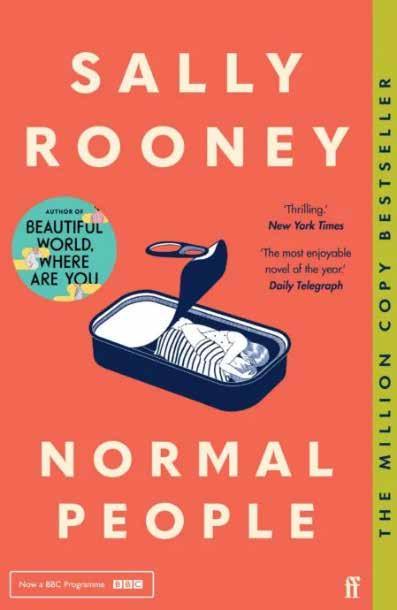
SESSION 1
20 21 SESSION X SESSION X
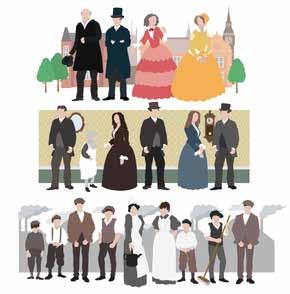



STATION 2: THE AUTHOR
a. Read the introduction to Sally Rooney and her writing on p. XX in this book.
b. Find the video “Sally Rooney: On Transforming Life into Novels” from Louisiana Channel and watch the part called “From adolescence to young adults” [3:455:43].
c. Based on your research and the video, what themes is Rooney interested in in her novels?
STATION 3: SUMMARIZE
a. Read the blurb on the back of the book.
b. What do you learn about: Who? Where? When? What? Why?
c. If your copy of the novel has short quotesfromreviews,whatdotheyemphasize?Howcanthisberelatedtothe information in the blurb?
STATION 4: THE FIRST PAGE
a. Read the first page of the novel. Pay attention to details!
b. Which characters do we meet?
c. How do they seem to know each other?
d. What do we learn about them?
STATION 5: PREDICTIONS
Look at the pictures. They all relate to Normal People in different ways. Based on the pictures, what do you think the novel might be about? Make three predictions.
4. Individually: Based on your work at the five different stations, how might Normal People be connected to your own life? Do you find any similarities in terms of themes or plot? Write for five minutes in your own notes. Share your thoughts with a partner.
RESEARCH
THE IRISH SCHOOL SYSTEM
1. Look up the Irish school system. How is it organized?
2. How does it compare to the Danish school system?
3. What is the Leaving Certificate?
4. What is a mock exam?
GETTING STARTED
THE FIRST CHAPTER
1. In class: Listen to or read the first chapter aloud together in class.
2. Next, write down:
a. Two questions you would like to have answered
b. Three observations about the chapter
c. Something that stands out to you
d. A short summary (50-75 words) of the chapter. Your summary should include the author, the title, the genre, and be written in the present tense.
22 23 SESSION X SESSION X
SUMMING UP THE CHAPTERS WRITE A SUMMARY
Write a summary (125-150 words) of the first six chapters of Normal People (January 2011-August 2011). Your summary must:
• Include the title, author, and genre
• Be written in the present tense
• Focus on who, what, where, and when
SUMMING UP THE CHAPTERS WHAT HAPPENS NEXT?
Marianne and Connell’s time in Sligo is now almost over, and they are getting ready for their new lives at Trinity College in Dublin. To sum up the first section of the book, please do the following:
1. Write down a question that you would like to have answered (based on the first 65 pages).
2. Pick a quote that you like from today’s readings.
3. Consider what might happen next in the story? What will Trinity be like for the two of them? Will they meet again? How will their relationship develop?
Share and explain your thoughts and ideas in pairs or groups.
LANGUAGE STYLE OF WRITING
Re-read the paragraph on p. 47 “The other night … wasted her life?”.
1. Which word classes are dominant in the paragraph?
2. Which word classes are used less or not at all? To what effect?
3. What do you notice about the sentence structure? What is the effect?
4. Rooney’s style has been called both “observing” and “intimate”. Find examples in the paragraph that support this description.
5. Consider what this style of writing adds to the portrait of her characters.
GRAMMAR VERBET ’DO’
Eksemplerne nedenfor indeholder alle en bøjning af verbet ’do’.
1. For hvert eksempel, skriv hvad der er hjælpeverbum og hovedverbum i sætningen.
2. Forklar de forskellige funktioner, som verbet do kan have. Inddrag alle eksemplerne i din forklaring.
a. “What the fuck did you do that for?” (p. 60)
b. “Yes, I know he did.” (p. 60)
c. “Do you want to?” (p. 61)
d. “I don’t feel like I’m that insatiable really.” (p. 61)
e. “I do already have you.” (p. 61)
f. “I don’t get what the joke-part was.” (p. 61)
3. Forklar hvorfor der ikke anvendes ’do’-omskrivning i følgende spørgende sætninger:
a. “But are you sleeping with her?” (p. 61)
b. “No, when would I even ever have time?” (p. 61)
c. “What is it, then?” (p. 61)
4. Skriv fire spørgsmål til Sally Rooney – du må spørge om alt! Mindst et af dine spørgsmål skal laves uden doomskrivning, ligesom du i dine sætninger skal anvende verbet ’do’ i alle funktioner (både som hjælpeverbum og hovedverbum).
5. Byt med en makker og se, om du kan finde og forklare brugen af ’do’ i alle din makkers fire sætninger.
SESSION 5
PP. 66-93 WARM-UP RELATIONSHIPS
1. Discuss the rules of a friendship and a romantic relationship. Are they different? Which actions do you consider “unforgiveable” in each type of relationship?
2. Do you think Marianne should forgive Connell for his behavior in school? Why (not)?
COMPREHENSION TWO TRUTHS AND A LIE
Look at the statements below and discuss which are true and which one is a lie. Use the text as evidence and explain your answer.
1. Connell’s perspective
a. Connell feels alienated at Trinity and starts to loathe himself.
b. Connell reacts very strongly when Marianne quits school, and he distances himself from his friends and gets involved with other girls, but still feels depressed.
c. Connell dates Rachel Moran over the summer to forget Marianne, and it does work and makes him feel less lonely for a while, but eventually they break up anyway.
2. Marianne’s perspective
a. Marianne’s friends at Trinity look down on Connell because he’s from a working-class background.
b. Marianne admits that she would be embarrassed if her new friends found out about her past relationship with Connell.
c. Connell apologizes to Marianne for his behavior in school and claims that he’s learned his lesson.
COMPREHENSION MAKE A LIST
Draw three columns and make a list of information about Connell’s first time in Dublin (pp. 66-71).
1. Column 1: How Connell describes people at Trinity.
2. Column 2: How Connell is different from people at Trinity .
3. Column 3: How Connell feels different from people at Trinity.
ANALYSIS CHARACTER DEVELOPMENT
Pick one of the two main characters and examine the development they each undergo as a result of the move from Sligo to Trinity College Dublin.
ANALYSIS MOOD BOARD
Create a mood board for one of the scenes below. A mood board is a type of collage which can be made up of everything from photos, art, quotations, words, colors, etc. The mood board visualizes the character, scene, mood, and atmosphere all at the same time – and you’re the art director!
Scenes:
a. Connell at Gareth’s party (pp. 66-69)
b. Connell in the summer (pp. 73-75)
c. Connell at the Debs (p. 76-77)
d. Connell and Marianne discuss the past (pp. 89b-92)
Present your mood boards in class or hang them around the room and do a gallery walk.
WWW
WWW
36 37 SESSION X SESSION X
SUMMING UP THE CHAPTERS CIRCLE UP!
The class is divided into larger groups of 8-10 students. The discussion questions are distributed among the group members, and each student is assigned one question for which they are responsible in the discussion.
1. Each group gathers in a circle and will now have a more informal discussion of the novel based on the questions.
2. One student is the group leader and will read the questions aloud as the discussion progresses.
3. The student responsible for each question will get the discussion going, and the other students must comment on at least three questions during the overall discussion.
USEFUL PHRASES FOR DISCUSSION
• I agree/disagree with you, because …
• In my opinion …
• As far as I’m concerned …
• I don’t think …
• On the one hand … on the other hand
a. Both Connell and Marianne have felt abandoned by the other person. How?
b. Do you think Connell really understands Marianne’s feelings and reaction to his abandonment? Why (not)?
c. Connell spent his summer without Marianne with several other girls. How did he feel when he was with them? What does this reveal about Connell?
d. How do Connell and Marianne see themselves? How can we tell? And how do they see each other? What does this tell us about them?
e. Why doesn’t Connell apologize to Marianne when he first meets her at the party? Instead, when does he apologize? And what does this apology also reveal about Connell?
f. How does Marianne compare to her friends Peggy and Joanna? How do they each see their futures? How does Marianne feel about her own future? How does this compare to how she used to feel about her life?
g. Comment on the quote: “But Marianne is aware, deep down, that that’s not why people think he’s stupid.” (p. 89) How do Marianne’s friends view Connell? And what is it that Marianne knows deep down?
h. What do we learn about the indirect importance of social class and money at Trinity? In the novel in general? How does this compare to Denmark? And what might explain the differences?
i. How does Connell react when he first learns that Eric and his friends from school knew about him and Marianne all along? How does Marianne react when Connell tells her? Why?
j. How would you characterize the connection between Connell and Marianne? Why are they seemingly drawn to each other? How does their connection compare to their connection with other people? Be specific.
k. Do you think Marianne makes a good choice when forgiving Connell? Why (not)? Think about your discussion on unforgivable actions from the warm-up earlier.
CREATIVE WRITING IMITATE ROONEY’S STYLE
Re-write the scene where Connell and Marianne meet for the first time at Trinity (pp. 72-73) from Marianne’s perspective. Before you write, consider the following:
1. What happens in the scene? In what order?
2. How do you think Marianne experiences the scene? What are her thoughts and feelings? Her reactions to Connell’s words?
3. What generally characterizes Rooney’s style of writing?
GRAMMAR TRANSLATION I
1. Translate the first 1-2 paragraphs of the chapter “Three Months Later (NOVEMBER 2011)” (p. 66) from English to Danish.
2. Next, consider the following: What difficulties did you encounter? Any words or phrases you had to pay special attention to?
3. Share your thoughts with a partner or in groups.
4. Discuss which parts of the text were easy to translate and which parts needed a little more thought. Can you explain these difficulties grammatically? Are there any grammatical areas that are difficult to translate directly into Danish? Why?
5. Share your thoughts in class. Put examples on the board and discuss the grammatical explanations.
GRAMMAR TRANSLATION II
1. Share your translation with a partner. Read each other’s translations and highlight words, phrases or sentences that seem “un-Danish” or “Danglish”.
2. Re-read your own translation and edit it according to your partner’s highlights. Remember, a translation must always work in the target language (here: Danish)!
3. Read Karen Fastrup’s official Danish translation of the paragraph on p. xx in this book.
4. What differences do you notice between your own and Fastrup’s translation? How could these differences be explained? Why do you think Fastrup chose a different wording than you did?
38 39 SESSION X SESSION X

MENTAL HEALTH THEME
3
THE BELL JAR
BY SYLVIA PLATH
The Bell Jar is the only novel written by the American author and poet, Sylvia Plath. The novel tells the autobiographical story of a young woman’s mental breakdown, hospitalization, and recovery. This excerpt is taken from the very beginning of the novel, in which the narrator, Esther Greenwood, has started an internship at a ladies’ magazine in New York.

WARM-UP LIVING IN A BELL JAR
In Sylvia Plath’s novel The Bell Jar, the narrator feels like she is living inside a bell jar.
1. What do you think it would be like to live inside a bell jar?
2. What might this title imply in terms of the narrator’s life, feelings, or experiences?
3. Do you feel the same way sometimes? When? Why?
PRE-READING FAMOUS FIRST LINES
In pairs: Below is a set of famous first lines from great British and American novels.
1. Read the first lines, one at a time. For each one, discuss what makes it a great first line. What thoughts are stirred? What is being hinted at? What about the tone?
2. Which one do you like the best? Why?
3. Read the first line of The Bell Jar What information do we get? What does this first line reveal about the narrator? Does it make you want to read on? Why (not)?

“It is a truth universally acknowledged, that a single man in possession of a good fortune, must be in want of a wife.”
(Jane Austen, Pride and Prejudice, 1814)
“I write this sitting in the kitchen sink.”
(Dodie Smith, I Capture the Castle , 1948)
“All this happened, more or less.”
(Kurt Vonnegut, Slaughterhouse Five, 1969)
“It was a wrong number that started it, the telephone ringing three times in the dead of night, and the voice on the other end asking for someone he was not.”
“We were somewhere around Barstow on the edge of the desert when the drugs began to take hold.”
(Hunter S. Thompson, Fear and Loathing in Las Vegas, 1971)
“I am an invisible man.”
(Ralph Ellison, Invisible Man, 1952)
(Paul Auster, City of Glass, 1993)
“It was a pleasure to burn.”
(Ray Bradbury, Fahrenheit 451 1953)
“We slept in what had once been the gymnasium.”
(Margaret Atwood, The Handmaid’s Tale, 1985)
“They shoot the white girl first. With the rest they take their time.”
(Toni Morrison, Paradise, 1997)
80 81
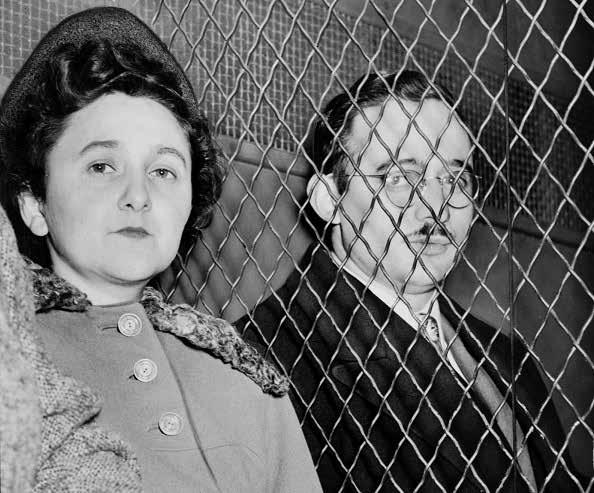
PRE-READING RESEARCH ETHEL AND JULIUS ROSENBERG
The narrator of The Bell Jar is obsessed with the execution of Ethel and Julius Rosenberg. But who were they? Why were they executed? And when?
1. Individually: Research the Rosenberg couple and write down five facts about them.
2. In pairs:
a. Take turns presenting one fact at a time.
b. What makes the Rosenbergs a fascinating story?
c. What could the narrator’s obsession with the Rosenbergs indicate about her?
The Bell Jar
One
It was a queer, sultry summer, the summer they electrocuted the Rosenbergs, and I didn’t know what I was doing in New York. I’m stupid about executions. The idea of being electrocuted makes me sick, and that’s all there was to read about in the papers – goggle-eyed headlines staring up at me on every street corner and at the fusty, peanut-smelling mouth of every subway. It had nothing to do with me, but I couldn’t help wondering what it would be like, being burned alive all along your nerves.
I thought it must be the worst thing in the world.
New York was bad enough. By nine in the morning the fake, country-wet freshness that somehow seeped in overnight evaporated like the tail end of a sweet dream. Mirage-gray at the bottom of their granite canyons, the hot streets wavered in the sun, the car tops sizzled and glittered, and the dry, cindery dust blew into my eyes and down my throat.
I kept hearing about the Rosenbergs over the radio and at the office till I couldn’t get them out of my mind. It was like the first time I saw a cadaver. For weeks afterward, the cadaver’s head – or what there was left of it – floated up behind my eggs and bacon at breakfast and behind the face of Buddy Willard, who was responsible for my seeing it in the first place, and pretty soon I felt as though I were carrying that cadaver’s head around with me on a string, like some black, noseless balloon stinking of vinegar.
I knew something was wrong with me that summer, because all I could think about was the Rosenbergs and how stupid I’d been to buy all those uncomfortable, expensive clothes, hanging limp as fish in my closet, and how all the little successes I’d totted up so happily at college fizzled to nothing outside the slick marble and plate-glass fronts along Madison Avenue.
I was supposed to be having the time of my life.
I was supposed to be the envy of thousands of other college girls just like me all over America who wanted nothing more than to be tripping about in those same size seven patent leather shoes I’d bought in Bloomingdale’s one lunch hour with a black patent leather belt and black patent leather pocketbook to match. And when my picture came out in the magazine the twelve of us were working on – drinking martinis in a
queer her: mærkelig, sær sultry lummer electrocute henrette i den elektriske stol Rosenbergs Ethel og Julius Rosenberg blev henrettet for russisk spionage i 1951 goggle-eyed med stirrende øjne fusty indelukket seep sive evaporate fordampe tail end den sidste del mirage-gray blød grå nuance canyon kløft waver flakke sizzle syde cindery fuld af slagge (restprodukt fra afbrænding af fx kul eller fremstilling af stål) cadaver kadaver, lig vinegar eddike limp slap tot up lægge sammen fizzle slutte på en skuffende måde slick glat marble marmor plate-glass spejlglas envy misundelse size 7 størrelse 37,5 patent leather lakeret læder Bloomingdale’s stormagasin med den nyeste mode skimpy mini(meget kort)
Julius and Ethel Rosenberg at their arrest.
82 83
silver-lamé sølvstof bodice kjoleliv (overdel) tulle tyl all-American ærkeamerikansk have a whirl have det rigtig sjovt steer styre numb følelsesløs trolleybus elektrisk bus, der får strøm gennem køreledninger hullabaloo spektakel
skimpy, imitation silver-lamé bodice stuck on to a big, fat cloud of white tulle, on some Starlight Roof, in the company of several anonymous young men with all-American bone structures hired or loaned for the occasion – everybody would think I must be having a real whirl.
Look what can happen in this country, they’d say. A girl lives in some out-of-the-way town for nineteen years, so poor she can’t afford a magazine, and then she gets a scholarship to college and wins a prize here and a prize there and ends up steering New York like her own private car. Only I wasn’t steering anything, not even myself. I just bumped from my hotel to work and to parties and from parties to my hotel and back to work like a numb trolleybus. I guess I should have been excited the way most of the other girls were, but I couldn’t get myself to react. I felt very still and very empty, the way the eye of a tornado must feel, moving dully along in the middle of the surrounding hullabaloo.
(1963)
COMPREHENSION MAKE A MIND-MAP
Make a mind-map of all the information you get about Esther, the narrator.
1. What is her background?
2. What is she doing in New York?
3. How does she feel in New York?
4. What is on her mind?
ANALYSIS USE OF COMPARISON
1. Comment on the narrator’s comparison between her fascination with the Rosenberg case and the first time she saw a cadaver.
a. What connotations does the word “cadaver” have?
b. What type of imagery is used in the comparison: “It was like the first time I saw a cadaver”?
c. According to Esther, what are the similarities between the two?
d. What does the comparison and her obsession with the Rosenbergs tell us about her state of mind?
2. Esther notes that she “was supposed to have the time of her life” in New York and then makes a comparison between her lived experiences and the way it may look to outsiders.
a. How do her actual experiences compare to what she was supposed to experience?
b. How does she imagine that “thousands of other college girls” would see her?
c. Find three words used by Esther to describe herself. For each word, find a synonym and an antonym.
3. At the end of the excerpt, Esther compares herself to the eye of a tornado.
a. How does she understand the connection? Explain the imagery.
b. What does this reveal about her situation?
ANALYSIS STYLE OF WRITING
Analyze the style of writing in ll. xx-xx [I was supposed to … having a real whirl.]
1. In pairs: Read the paragraph aloud. Does anything affect your ability to read the text aloud? Why? What else do you notice about the language (word classes, repetition of words and sounds, imagery, etc.)? Make a list.
2. In groups or in class: Share your initial observations about the language and the effect created.
3. How does Plath use the style of writing (including the punctuation) to tell us something about Esther? What impression do you get of her? Why?
4. Make a list of the adjectives used in the paragraph. What are they used to describe? Why do you think Plath uses this number of adjectives to describe these items? What does this tell us about Esther and her view of herself and her surroundings?
5. Re-write the paragraph to make it easier to read. You can change the punctuation or add and delete words – whatever you think will help.
6. Read your re-written paragraphs aloud in pairs or groups and discuss how your changes affect your perception of Esther.
84 85

THEME STARCROSSED LOVE
4
PRIDE AND PREJUDICE
BY JANE AUSTEN
Jane Austen’s novel Pride and Prejudice (1813) is a story of first impressions, love and attraction, and the importance of marriage, wealth, and class during the Regency Period (1811-1820) in England. In the excerpt, the protagonist and daughter of a gentleman, Elizabeth Bennet, is confronted by Lady Catherine de Bourgh, who wishes to discuss Elizabeth’s potential marriage to a wealthy aristocrat, Mr. Darcy.
Elizabeth has four sisters, who are all in need of a husband: Jane (who was recently engaged to a Mr. Bingley), Mary, Kitty, and Lydia. In the excerpt, we also meet Elizabeth’s mother, Mrs. Bennet.
WARM-UP PRIDE, PREJUDICE, AND PREDICTIONS
In pairs:
1. How can pride (being proud) and prejudice (being prejudiced or being faced with prejudice) affect your life and relationships?
2. Do an image search for “Pride and Prejudice book covers”. Based on the many (!) different covers made for the novel, what do you think the story might be about? What themes or conflicts are hinted at by the various covers?
3. Based on this, what role do you think “pride” and “prejudice” could have in the novel?
PRE-READING
THE REGENCY PERIOD
1. Read about the Regency Period in the box below.
2. Find and watch the trailer for the 2005 movie version of Pride and Prejudice. You may want to watch it more than once to answer the questions below.
3. How does the trailer portray women, the view on marriage, and the role of social class in this period?
4. How does Elizabeth Bennet seem to differ from other women?
5. How does the trailer reflect what you have already read about the Regency Period?
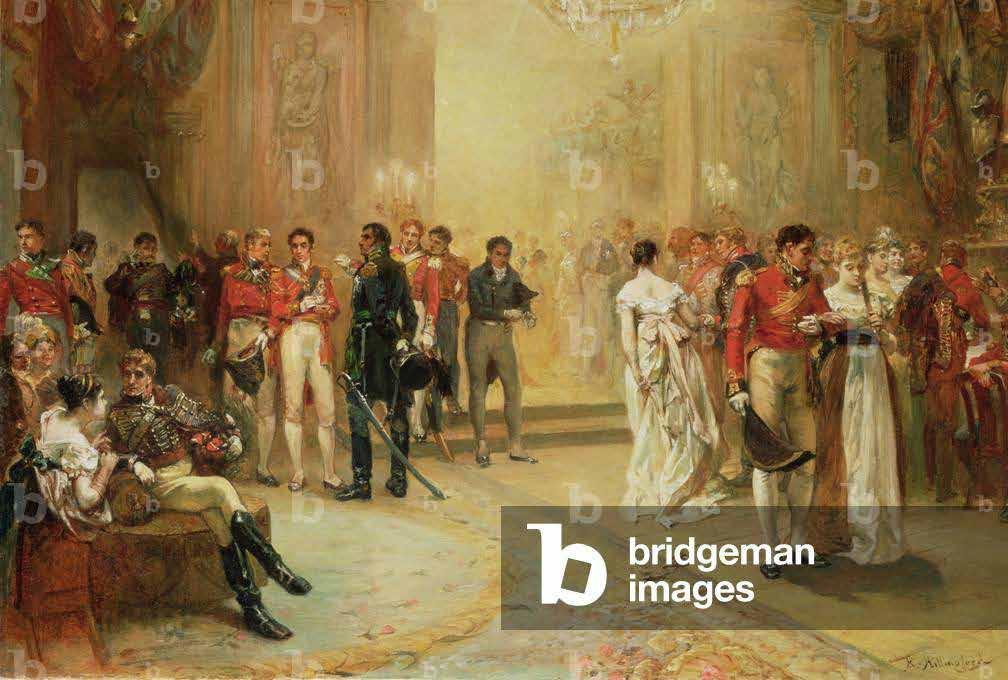
THE REGENCY PERIOD
In Britain, the Regency Period (18111820) is part of the Georgian Era (named after kings George I, II, III and IV). It was a time of both tradition and transition. In 1811, King George III was officially excepted from his royal duties because of his mental illness and replaced by his son, the Prince Regent (hence the name Regency Period), who later became King George IV in 1820.
The Regency Period was a male-dominated world with a strict social hierarchy based on titles, ancestry, and occupation. Marriage was the most important aspect of a woman’s life, and the wealth and social position of her family most often determined the direction of her future. Marriage was also seen as a way to gain more wealth, and women were thus strategically used by men for financial gain. Similarly, marrying below one’s social position was frowned upon.
The social hierarchy of the period can be loosely divided like this:
1. Monarchy (members of the royal family)
2. Nobility (so-called “peers”; e.g. dukes, earls, and barons with seats in the House of Lords)
3. Gentry (so-called “gentlemen”; landowners, lawyers, doctors)
4. Laboring classes (tradesmen, merchants, servants)
5. Paupers (vagabonds, outcasts, criminals)
The Georgian Era did, however, also see the beginning of the Industrial Revolution and a consequent change in power relations and distribution of wealth. This created a new, more prominent middle class of manufacturers and merchants, while professions like doctors and lawyers also became more influential.
128 129
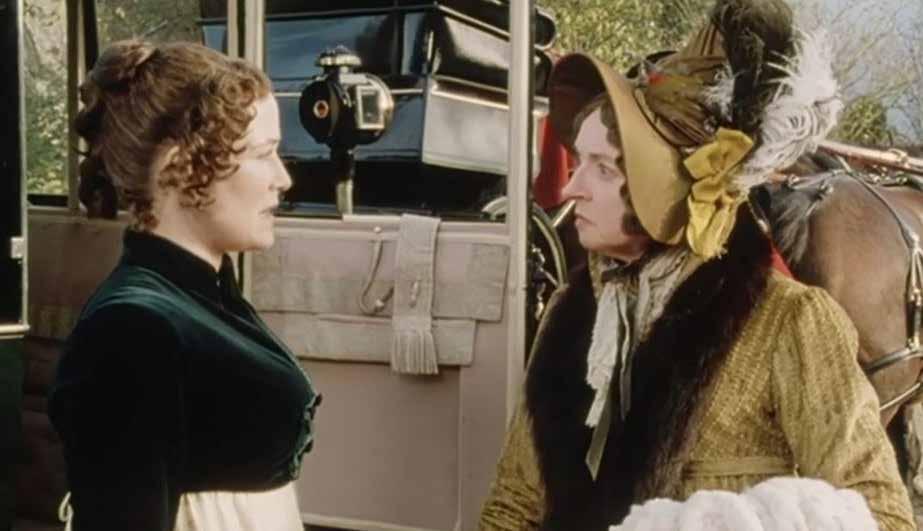
COMPREHENSION ROLE-READING
In groups of 4-5: Read the excerpt from Pride and Prejudice together in groups.
Student A: Reads aloud.
Student B: Summarizes.
Student C: Finds 2-3 keywords in the text (NB: save for later!)
Student D: Asks two questions about the text.
Student E (or the group): Answers the questions.
Section 1: lines xx-xx
Section 2: lines xx-xx
Section 3: lines xx-xx
Section 4: lines xx-xx
Section 5: lines xx-xx
Pride and Prejudice
Chapter 56
[section 1:] One morning, about a week after Bingley’s engagement with Jane had been formed, as he and the females of the family were sitting together in the dining-room, their attention was suddenly drawn to the window, by the sound of a carriage; and they perceived a chaise and four driving up the lawn. It was too early in the morning for visitors, and besides, the equipage did not answer to that of any of their neighbours. The horses were post; and neither the carriage, nor the livery of the servant who preceded it, were familiar to them. As it was certain, however, that somebody was coming, Bingley instantly prevailed on Miss Bennet to avoid the confinement of such an intrusion, and walk away with him into the shrubbery. They both set off, and the conjectures of the remaining three continued, though with little satisfaction, till the door was thrown open and their visitor entered. It was Lady Catherine de Bourgh.
They were of course all intending to be surprised; but their astonishment was beyond their expectation; and on the part of Mrs. Bennet and Kitty, though she was perfectly unknown to them, even inferior to what Elizabeth felt.
She entered the room with an air more than usually ungracious, made no other reply to Elizabeth’s salutation than a slight inclination of the head, and sat down without saying a word. Elizabeth had mentioned her name to her mother on her ladyship’s entrance, though no request of introduction had been made. […]
[section 2]: As soon as they entered the copse, Lady Catherine began in the following manner: –
“You can be at no loss, Miss Bennet, to understand the reason of my journey hither. Your own heart, your own conscience, must tell you why I come.”
Elizabeth looked with unaffected astonishment.
“Indeed, you are mistaken, Madam. I have not been at all able to account for the honour of seeing you here.”
“Miss Bennet,” replied her ladyship, in an angry tone, “you ought to know, that I am not to be trifled with. But however insincere you may engagement forlovelse perceive se chaise and four lukket hestevogn med fire heste spændt for equipage vogn post lejet, udskiftet undervejs livery uniform prevail on overtale confinement indespærring intrusion forstyrrelse shrubbery buskads conjecture gætteri intending have til hensigt, lade som om astonishment forbavselse inferior underlegen, mindre air ansigtsudtryk ungracious uvenligt salutation hilsen slight ubetydelig inclination hældning copse lille skov be at no loss ikke være i tvivl om hither herhen
130 131
THE FAULT IN OUR STARS
BY JOHN GREEN
John Green is an acclaimed writer of Young Adult fiction. His novel The Fault in Our Stars (2012) has received much attention (positive as well as negative) for tackling difficult topics like teenage cancer, death, loss, and depression. However, the novel is also about fate, first love, sarcastic teenagers, and eventually finding one’s own way in life. The novel was made into a movie in 2014.
WARM-UP WOULD YOU RATHER ...?
In pairs: Discuss the dilemmas below and give reasons for your choices and opinions. You don’t have to agree with each other, but you can ask your partner follow-up questions if you are curious.
1. Would you rather lose your eyesight or your hearing? Why?
2. Would you rather love with all your heart and then lose the person you have fallen in love with way too soon, than never fall in love at all? Why?
3. If you only had one month left to live, would you keep the secret from your loved ones or tell them the truth? Why?
PRE-READING PREDICTIONS
The Fault in Our Stars tells the story of Hazel Grace and Augustus Waters: how they meet, fall in love, and go on to affect each other’s lives in different ways.
1. Look at the word cloud below, which consists of the 50 most common words from the first part of chapter
2. Which words stand out to you? Which seem to be the most frequent ones? What does the word cloud tell you about the story? Based on these words, what do you think the text might be about?
3. Consider the title: What does the title hint at when it comes to Hazel and Augustus’ relationship? Think about your work with Romeo and Juliet and the original meaning of being “star-crossed”.
PRE-READING GETTING STARTED
1. Read the first paragraph of chapter one. (ll. 1-xx?)
a. What type of narrator do we meet? What typically characterizes this kind of narrator?
b. What is your impression of the narrator? Why?
c. What does the narrator think about the situation? How can you tell?
2. Read ll. xx-xx [“Whenever you read”-“sacred heart and whatever”.]
a. What is Hazel’s opinion on her depression diagnosis?
b. What do we learn about Hazel’s support group? Who attends? Where do they meet? What do they do?
c. How does Hazel feel about her support group? Why do you think that is?
d. Pick five words from ll. 1-xx that tell us something about Hazel’s thoughts about or feelings towards the situation. real cross late whole five die jesus cast isacc depression head took whatever effect group person heart met church eye fact almost years eyes around quite time always side dying support mom every read one cancer life patrick kid circle room basement sat lot right wednesday living sitting made say
138 139













